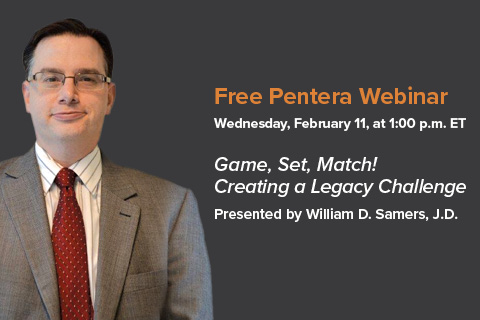
The Pentera Blog
Transformational Blended Gifts Help the Charity and the Donor
Blended gifts are a hot topic in planned giving today—and for good reason: Combining different types of charitable gifts can be transformational to the donor in terms of achieving charitable goals and also transformational for the organization whose mission can be advanced significantly.
Pentera has written extensively about blended gifts, including several newsletters and booklets. At last year's National Conference on Philanthropic Planning, two workshops focused on blended gifts: Speakers from The Nature Conservancy led a workshop titled "Transformational Blended Gifts: Shifting the Organizational Culture," while Steven Meyers of the American Committee for the Weizmann Institute of Science offered a workshop called "Blended Giving with the Killer Apps of Personalized Philanthropy." Both workshops talked about the power of crossing the divide that separates planned gifts, annual gifts, and major gifts.
Here is some of what they both said:
Transformational Blended Gifts: Shifting the Organizational Culture
Katherine Skinner, State Director, North Carolina Chapter
Ed Cadogan, Senior Regional Gift Planner
The Nature Conservancy
"The Nature Conservancy is embarking on the largest campaign in conservation history—our $6.6 billion Our World Global Campaign is about focusing our efforts on the world's most pressing challenges and using that forward momentum to achieve an ambitious set of goals we have outlined in our global conservation agenda," Katherine Skinner explained. "In order for us to achieve our goals, donors are being asked for transformational gifts: gifts they may not have thought capable of giving, but through philanthropic blended gifts discussions, they can envision how their philanthropic conservation goals can be accomplished.
"We have, like many other organizations, struggled with incorporating blended gifts into our organizational culture. But we are implementing best practices and seeing great success in several national chapters, especially in North Carolina."
The approach is to use a blend of gift vehicles to address all of a donor's objectives: philanthropic, financial planning, and family or personal.
Skinner explained that prior to this new strategy, The Nature Conservancy had been "leaving 'assets' on the table in the form of planned gifts." But she said that adding the request for an estate component to another gift turned out to be donor-centric—many donors were ready and willing to talk about it. And doing so had no negative impact on outright giving.
"Despite concerns from organizational leadership that a deferred gift will negatively impact a donor's outright giving, at The Nature Conservancy donors actually increase their outright giving after becoming Legacy Club members," Skinner said.
Blended Giving with the Killer Apps of Personalized Philanthropy
Steven L. Meyers, Ph.D., Vice President for Planned Giving
American Committee for the Weizmann Institute of Science
Meyers says that blended gifts can be changed from merely transactional to transformational through personalized philanthropy—"meshing the most compelling interests of donors with the most compelling needs of the institution they care so passionately about." That often includes blending gifts to address current and future needs.
"The link between current and future needs seems compelling, natural, and organic," he said. "However, in the conventional fundraising and development office, that link is broken. Conventional fundraising and institutional advancement offices divide donors and fundraisers into separate departments for annual, major, and planned gifts. The connection between current dollars and future dollars is often severed or never even established.
"Personalized philanthropy is a radical rethinking of endowment, as well as annual/major/planned giving. The strategies are all about repairing and restoring this connection by eliminating the channels and gaining a clear view of the donor's big picture over their lifetime of giving."
He promotes three "game-changing personalized gift designs" he calls the "Killer Apps." Here are his descriptions:
- Virtual Endowment—Donor combines and in effect chains together a series of current gifts of a "spending rate" amount that will maintain a program with a future gift (a bequest or other balloon payment) to endow the program.
- Philanthropic Mortgage—Donor's annual gift commitment covers an amount greater than that needed for maintenance of the program. The surplus amount is used to gradually build equity in an endowment or a legacy fund until fully established and able to sustain the program for the future.
- Step-up Gifts—Donor establishes a gift at a starting level with an outright gift or, alternatively, current spending rate annual gifts and then steps it up.
In his presentations Meyers then leads a breakout session in which small groups do an activity using the three gift designs with different kinds of donors.
"The whole spectrum of all gifts could be available and flow into a major project," Meyers explained. "All manner of gifts could be staged over a lifetime and targeted around impact. Every gift would count, no matter how small, toward that greater goal. Gifts that were large and small, expendable and endowed, irrevocable and revocable. Transformational."


